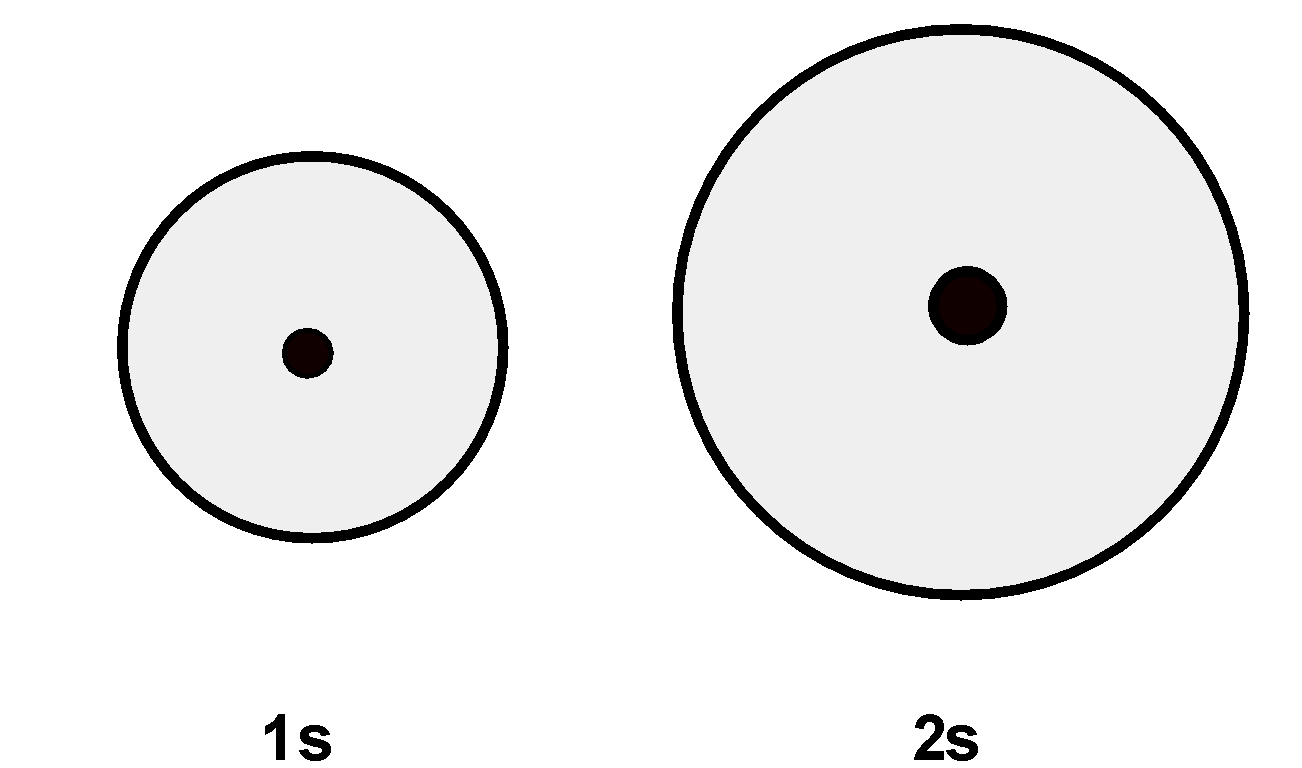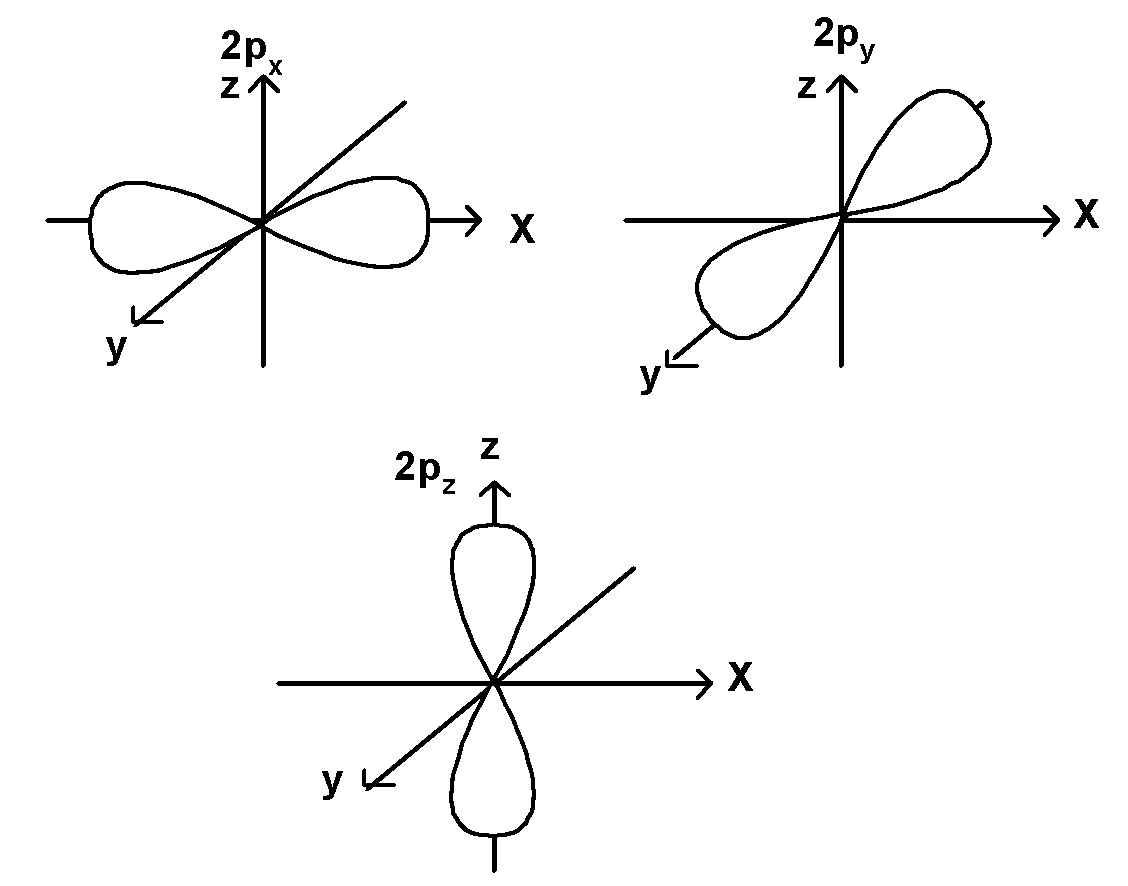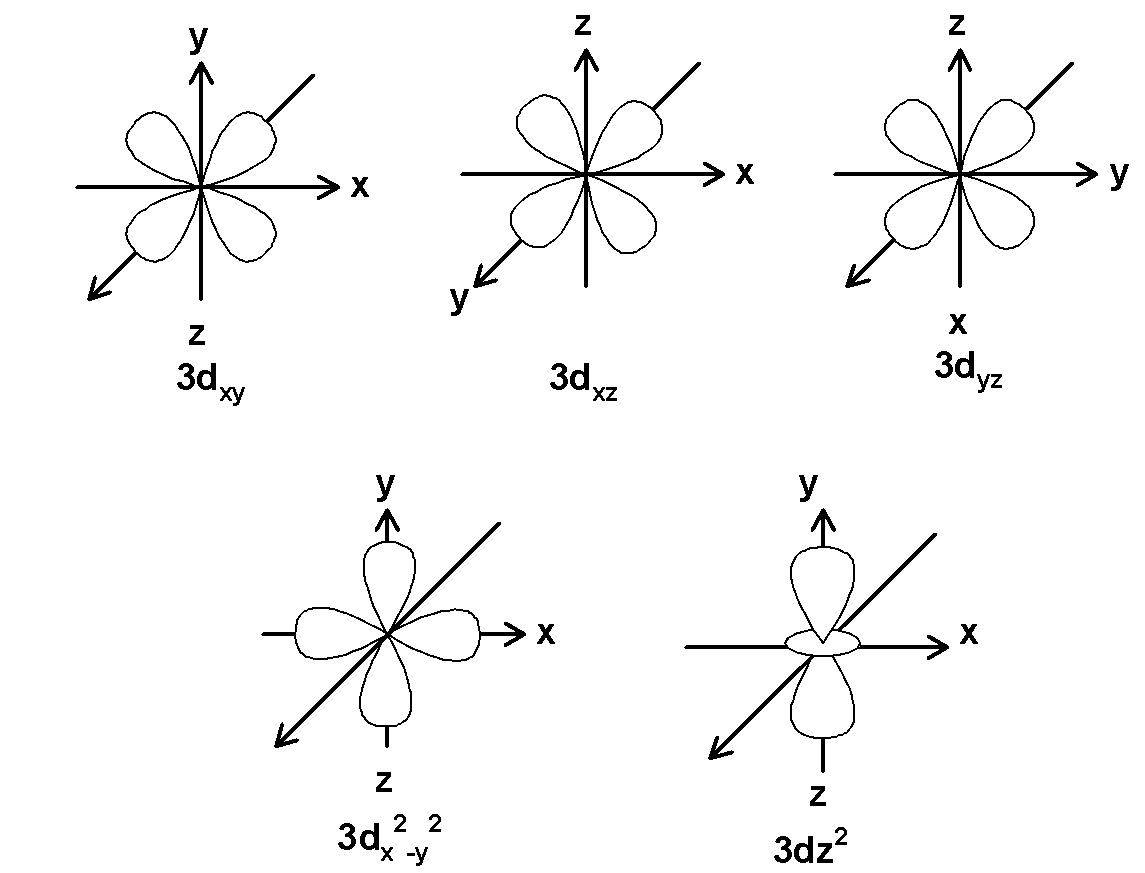
What is an orbital? Draw the shapes of the 1s, 2s, $\text{ 2}{{\text{p}}_{\text{x}}}\text{ }$ , $\text{ 2}{{\text{p}}_{\text{y}}}\text{ }$,$\text{ 2}{{\text{p}}_{\text{z}}}\text{ }$, $\text{ 3}{{\text{d}}_{\text{xy}}}\text{ }$ , $\text{ 3}{{\text{d}}_{\text{yz}}}\text{ }$, $\text{ 3}{{\text{d}}_{\text{xz }}}\text{ }$,$\text{ 3}{{\text{d}}_{{{\text{x}}^{\text{2}}}-{{\text{y}}^{\text{2}}}}}\text{ }$and $\text{ 3}{{\text{d}}_{{{z}^{2}}}}\text{ }$orbitals.
Answer
557.1k+ views
Hint: Orbitals are the regions in the atom in which electrons are more likely to be found. Three are four different types of orbitals. These are s, p , d , and f .s is a spherical orbital, p is a dumbbell-shaped orbital, d are a double dumbbell-shaped orbital and f orbitals have a more complex structure.
Complete Solution :
An orbital is a three-dimensional representation of a region in which the electrons are more likely to be found around the atom.in atomic orbitals, the orbital is the mathematical function that describes the location of an electron in the atom. Each orbital of an atom has a unique set of three quantum numbers which are principal quantum number(n), azimuthal quantum number (l), and magnetic quantum number (m) .this orbitals have a characteristic shape. This is as follows:
1) s-orbital:
It is a completely spherical and symmetrical orbital. These orbitals are closest to the nucleus.as the principal quantum number increases these orbitals get bigger. The order of the s-orbitals is as follows,
$\text{ 1s }<\text{ 2s }<\text{ 3s }<\text{ 4s }$
S orbitals do not have a node. The s orbital is as shown below,

The 1 s and 2s orbital are drawn as follows,

2) p-orbital:
It is a dumbbell-shaped orbital. p orbitals have a node. The p orbitals can occupy six electrons as there are a total of three p orbitals. This three p orbitals are mutually perpendicular to each other and aligned towards the three axes x, y and these three p-orbitals are shown below,

3) d-orbital:
d orbital is double dumbbell-shaped orbitals. This has a cloverleaf shape in the plane. ‘d’ orbitals have an azimuthal quantum number equal to 2 and the minimum quantum number for d-orbitals are 3.the value for the ‘l’ can range from $\text{ }-2\text{ , }-1\text{ , 0 , +1 , +2 }$ . Thus there are a total of five d-orbitals. These 5 d orbitals are designated as $\text{ }{{\text{d}}_{\text{xy}}}\text{ }$ , $\text{ }{{\text{d}}_{\text{yz}}}\text{ }$, $\text{ }{{\text{d}}_{\text{xz }}}\text{ }$,$\text{ }{{\text{d}}_{{{\text{x}}^{\text{2}}}-{{\text{y}}^{\text{2}}}}}\text{ }$ and $\text{ }{{\text{d}}_{{{z}^{2}}}}\text{ }$. The five orbitals for principal quantum number 3 are as shown below,

Note: Note that, orbitals show the probability of finding an electron in an atom. There are 4 orbitals and their names as s stand for sharp, p for principle, d for diffuse, and f for fundamental. S orbital shield nucleus well but p, d, or f orbitals have a diffused shape thus shields the nucleus poorly.
Complete Solution :
An orbital is a three-dimensional representation of a region in which the electrons are more likely to be found around the atom.in atomic orbitals, the orbital is the mathematical function that describes the location of an electron in the atom. Each orbital of an atom has a unique set of three quantum numbers which are principal quantum number(n), azimuthal quantum number (l), and magnetic quantum number (m) .this orbitals have a characteristic shape. This is as follows:
1) s-orbital:
It is a completely spherical and symmetrical orbital. These orbitals are closest to the nucleus.as the principal quantum number increases these orbitals get bigger. The order of the s-orbitals is as follows,
$\text{ 1s }<\text{ 2s }<\text{ 3s }<\text{ 4s }$
S orbitals do not have a node. The s orbital is as shown below,

The 1 s and 2s orbital are drawn as follows,

2) p-orbital:
It is a dumbbell-shaped orbital. p orbitals have a node. The p orbitals can occupy six electrons as there are a total of three p orbitals. This three p orbitals are mutually perpendicular to each other and aligned towards the three axes x, y and these three p-orbitals are shown below,

3) d-orbital:
d orbital is double dumbbell-shaped orbitals. This has a cloverleaf shape in the plane. ‘d’ orbitals have an azimuthal quantum number equal to 2 and the minimum quantum number for d-orbitals are 3.the value for the ‘l’ can range from $\text{ }-2\text{ , }-1\text{ , 0 , +1 , +2 }$ . Thus there are a total of five d-orbitals. These 5 d orbitals are designated as $\text{ }{{\text{d}}_{\text{xy}}}\text{ }$ , $\text{ }{{\text{d}}_{\text{yz}}}\text{ }$, $\text{ }{{\text{d}}_{\text{xz }}}\text{ }$,$\text{ }{{\text{d}}_{{{\text{x}}^{\text{2}}}-{{\text{y}}^{\text{2}}}}}\text{ }$ and $\text{ }{{\text{d}}_{{{z}^{2}}}}\text{ }$. The five orbitals for principal quantum number 3 are as shown below,

Note: Note that, orbitals show the probability of finding an electron in an atom. There are 4 orbitals and their names as s stand for sharp, p for principle, d for diffuse, and f for fundamental. S orbital shield nucleus well but p, d, or f orbitals have a diffused shape thus shields the nucleus poorly.
Recently Updated Pages
Master Class 12 Business Studies: Engaging Questions & Answers for Success

Master Class 12 Economics: Engaging Questions & Answers for Success

Master Class 12 English: Engaging Questions & Answers for Success

Master Class 12 Maths: Engaging Questions & Answers for Success

Master Class 12 Social Science: Engaging Questions & Answers for Success

Master Class 12 Chemistry: Engaging Questions & Answers for Success

Trending doubts
Which animal has three hearts class 11 biology CBSE

1 Quintal is equal to a 110 kg b 10 kg c 100kg d 1000 class 11 physics CBSE

Explain zero factorial class 11 maths CBSE

The camels hump is made of which tissues a Skeletal class 11 biology CBSE

How do I convert ms to kmh Give an example class 11 physics CBSE

The percentage of free SO3 in oleum sample which is class 11 chemistry CBSE




